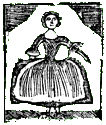 I spent most of Monday at the "Outside the Textbook" conference on public history, sponsored by the Massachusetts Foundation for the Humanities. It was a very pleasant, if occasionally inaudible, day. Gretchen Adams of the Paul Revere House said extraordinarily nice things about a teacher's workshop I led there in 2002. Wendy Lement of Theatre Espresso shared some of her plans for an educational drama about the Boston Massacre, "Uprising on King Street." And I enjoyed meeting and hearing from many other people who are researching, writing, and presenting Massachusetts history of periods other than the Revolution.
I spent most of Monday at the "Outside the Textbook" conference on public history, sponsored by the Massachusetts Foundation for the Humanities. It was a very pleasant, if occasionally inaudible, day. Gretchen Adams of the Paul Revere House said extraordinarily nice things about a teacher's workshop I led there in 2002. Wendy Lement of Theatre Espresso shared some of her plans for an educational drama about the Boston Massacre, "Uprising on King Street." And I enjoyed meeting and hearing from many other people who are researching, writing, and presenting Massachusetts history of periods other than the Revolution.Graciously postponing lunch, Charles Swift gave me a behind-the-scenes tour of his City Record and Boston News-Letter blog, one inspiration for finally getting this one off the ground. Charles's entry for Monday discusses the original name for the area of Boston renamed "Mount Vernon" and "Louisburg Square" by real-estate developers after the Revolution. In the pre-war period it was called "Mount Whoredom" because of the high concentration of prostitutes working in that somewhat-out-of-the-way area to the west of the Common.
Interestingly, the "Whoredom" name appears most often in documents and on maps created by British army officers, such as the map of Boston by Lt Thomas Page that Charles's blog highlights. Other examples:
Lt Frederick Mackenzie, diary, 25 Apr 1775: "Our Regiment Encamped his morning on Fort Hill; The 4th Regiment on Mount Whoredom, and the Marines on the Common."The British officers clearly savored the irony of the puritanical town having a red-light district. And perhaps some savored the district as well.
Lt John Barker, diary, 26 Apr 1775: “the 1st upon Whoredom Hill.”
Gen. Percy, letter to his clergyman uncle: "Camp on Mount Whoredom, Augt. 12. 1775. . . . A strange Place Dear Dr. to write from to a Clergyman—Yet so it is, My Tent is upon the highest Summit of it.”
Gen. George Washington, on the other hand, used a delicate misspelling when writing to the Continental Congress on 7 Mar 1776 about contingency plans to storm Boston:
Four thousand chosen men who were held in readiness, were to ford have embarked at the mouth of Cambridge River in two divisions; The first under the command of Brig. Genl. Sullivan, the second under Brig. Genl. Greene, the whole to have been commanded by Major General Putnam. The first division was to land at the Powder House and gain possession of Bacon Hill and Mount Horam.Less than two weeks before, when Greene, Putnam, Sullivan, and Gen. Horatio Gates had drawn up this plan for Washington, they had used the label "Mount Whoredom." So the generalissimo knew what the hill's real name was.
ADDENDUM: New older information on “Mount Whoredom” here.
"Mount Whoredom" was a name attached to the place by the occupying British. David McCullough wrote in 1776: "For their part, the British had assigned an experienced cartographer, Lieutenant Richard Williams, who, with the help of a small crew, moved his surveyor's transit and brass chains from one vantage point to the next, taking and recording careful sightings. The result was a beautifully delineated, hand-colored map showing 'the True Situation of His Majesty's Army and also those of the Rebels.' All fortifications were clearly marked, all landmarks neatly labeled, including 'Mount Whoredom,' Boston's red-light district. Lieutenant Williams had been appalled to find prostitution so in evidence in what was supposedly a center of Puritanism -- 'There's perhaps no town of its size could turn out more whores than this could,' he noted in his journal -- and accuracy demanded that this, too, be shown on the map." (p. 27)
ReplyDeleteMy question is this: Was that the name Bostonians used prior to the British occupation?
It's a good question, in that the name "Mount Whoredom" didn't appear on the few Boston maps before 1775. But that hill didn't appear on the maps, either, under any name. The British military engineers did a better job of mapping topographical features as well as being the first to apply the "Mount Whoredom" label on paper.
ReplyDeleteI believe "Mount Whoredom" was a popular but unofficial term for that part of west Boston before the British army occupation. New England army commanders used the term in their recommendations to Washington, as shown in the Papers of Nathanael Greene. I've never read a complaint from locals about the British unfairly applying that name to part of the Boston landscape. None of the British officers who used the label claimed that it was a witty coinage of one of their colleagues. And that area west of Boston Common was known before the war for its houses of ill repute.
As an addendum, I just found the phrase "Mount Whoredom" used in an essay published in the 17 Nov 1788 Herald of Freedom, and Federal Advertiser, published in Boston. The rather opaque essay about treasure-hunting describes pre-Revolutionary times. While this doesn't prove the term was in use before the war, it shows that Bostonians didn't discard it with the departure of the British military.
ReplyDeleteThe euphemistic "Mount Horam" label appears in the 26 Jan 1824 Boston Commercial Gazette in one of a series of "Recollections of a Bostonian" signing himself "Senex." That was the original term for Mount Vernon, the writer claimed. If so, it had escaped notice of every newspaper and broadside and map that have been indexed.